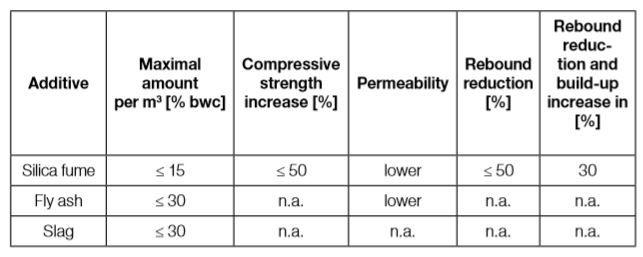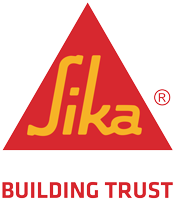Additives as sprayed concrete constituent material in Mining Industry | South Africa
The most commonly used additives in sprayed concrete are fly ash, ground granulated blast furnace slag and silica fume. These additions shall comply with the relevant European standards or national standards or regulations valid in the place of use of the sprayed concrete. Where appropriate standards and/or regulations do not exist, the use of additives shall comply with the recommendations of the suppliers.
The use of additives for permanent structures shall match the requirements of EN 206-1 or national standards and regulations valid in the place of use.
Contractors are allowed to add approved cementitious materials within the following limits shown on Table 3-7, unless otherwise directed by the client’s representative. Cementitious materials as a cement replacement shall not exceed these relative proportions.
![Table 3-7: Maximum level of additives (by weight) according to EFNARC [29], Table 5.3.1.](https://assets.construction-chemicals.mbcc-group.com/en-za/maximum%20level%20of%20additives.jpg)
Table 3-7: Maximum level of additives (by weight) according to EFNARC [29], Table 5.3.1.
Silica fume (Microsilica)
As described by Tsohos & Oppliger in [38], silica fume (SF) is a byproduct of the manufacturing of silicon or ferrosilicon alloys produced in electric furnaces. Silica fume is distinguished as:
- undensified
- densified
- aqueous slurry (Note: approx. 30-50 % solid content by weight)
Silica fume consists of approx. 85 % of SiO2 (quartz), humidity and some minor fractions. It is approx. 100 times finer than cement and contributes to the following concrete properties:
- better pumpability, less segregation and bleeding
- less rebound
- improved adhesion at surface
- increased build-up
- prevents applied concrete from sagging
- higher final strength and lower permeability
- reduction of alkali aggregate reaction (AAR)
- higher durability
Due to its fineness and its chemical composition, silica fume is a pozzolanic (reactive) material. It does not contribute to either setting or early strength but to the final strength of sprayed concrete. A typical dosage in a sprayed concrete mix ranges from 20 to 40 kg/m3. Microsilica can basically replace a certain amount of cement, but it should be used as an additive rather than as a cement replacement.
The activity index for silica fume is the ratio (in percent) of the compressive strength of standard mortar bars, prepared with 90 % cement plus 10 % silica fume by mass, to the compressive strength of standard mortar bars made from cement only (Norwegian Standard NS 3045). The following diagram in Figure 3-9 shows the strength development of concrete mixes with different microsilica (MS) contents.
![Figure 3-9: Typical strength development of mixes containing different portions of silica fume [38]](https://assets.construction-chemicals.mbcc-group.com/en-za/typical%20strength%20development%20of%20mixes%20containing%20different%20portions%20of%20silica%20fume.jpg)
Figure 3-9: Typical strength development of mixes containing different portions of silica fume
Normal sprayed concrete qualities, i.e. 20 to 40 MPa cube strengths, can be produced without microsilica, whereas practical and economical production of higher strength performances (50–60 MPa) can be achieved by the addition of microsilica, even with reduced cement content (less than 400 kg/m3). It seems favorable from a technical point of view to use 5 to 10 % bcw of microsilica.
The w/c ratio may need to be adjusted (slightly increased) by using microsilica. However, one of the major benefits is a higher density of the microstructure of concrete, which delivers lower permeability. This contributes to durability. According to [49] “Whereas microsilica contributes to higher performances in wet mixes, dry mixes do not show significant strength increases.” Silica fume was introduced to sprayed concrete in the 1970s, initially in Norway.
Fly ash (Pulverized Fuel Ash or PFA)
According to EN 197-1, part 1, “Fly ash (PFA) is obtained by electrostatic or mechanical precipitation of dust-like particles from the flue gases from furnaces fired with pulverized coal.”
According to ASTM, fly-ashes are separated into two classes:
- Class F: low-lime content (low reactivity), and
- Class C: high-lime content (highly reactive but not used for sprayed concrete applications).
The effect of fly-ash on the properties of the concrete is considerable. During the mixing process the fly-ash acts as blended cement or as a replacement of the fine part of aggregates. Slow response to sprayed concrete accelerators has to be taken into account. Fly ash typically contributes positively to workability/pumpability, as well as to long-term performances and durability.
Ground Granulated Blast Furnace Slag (BFS, GGBS, GGBFS)
Granulated blast furnace slag is made by rapidly cooling a slag melt of suitable composition. As described by Tsohos & Oppliger in [38], blast furnace slag contains 95 % or more oxides (silica alumina, lime and magnesia). It is classified in grades 120 – 100 – 80, based on the slag activity index (SAI). The chemical composition of the GBFS depends on the production process and the origin of the raw material.
Although GBFS contributes to pumpability, it is not often used in sprayed concrete. GBFS has a latent hydraulic potential which leads to a slow response to sprayed concrete accelerators.
Limestone
A sedimentary rock, limestone’s predominant minerals are calcite and calcium carbonate (CaCO3), making up more than 75 % of its composition. Limestone is rarely added to sprayed concrete mixes and is considered an inert (non reactive) filler.
Summary
In addition to mix design, aggregates, w/c and application method, additives contribute substantially to strength, durability as well as to economic improvements.

Table 3-8: Contributions of additives to sprayed concrete performance

